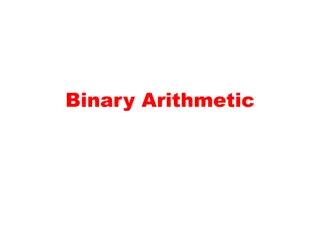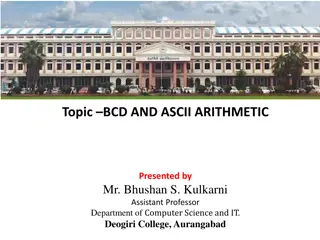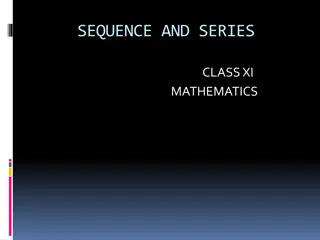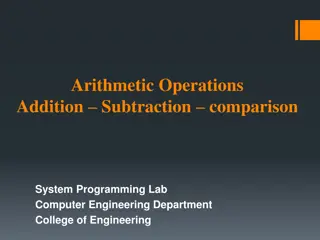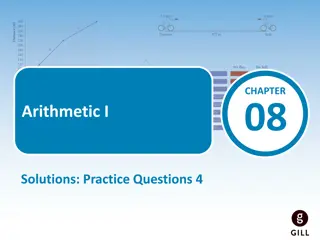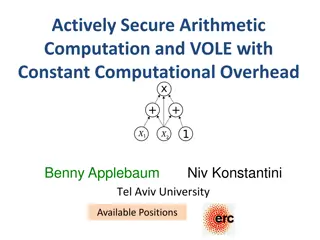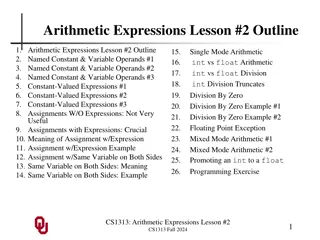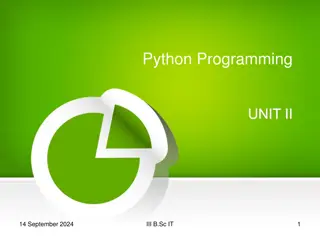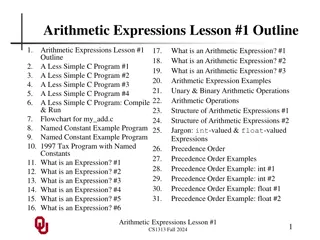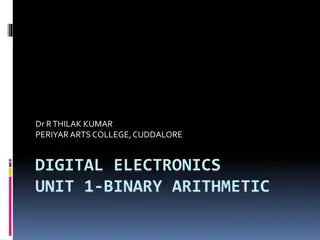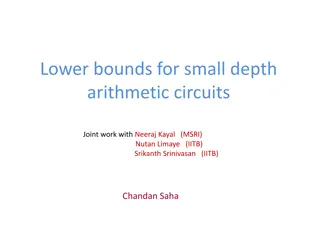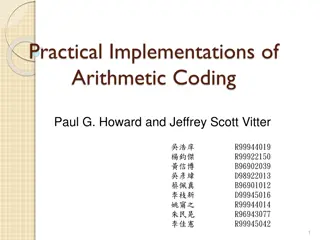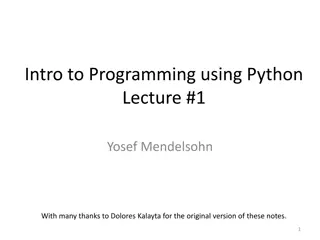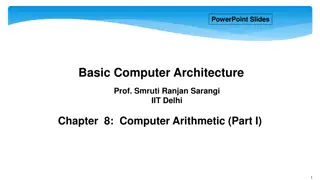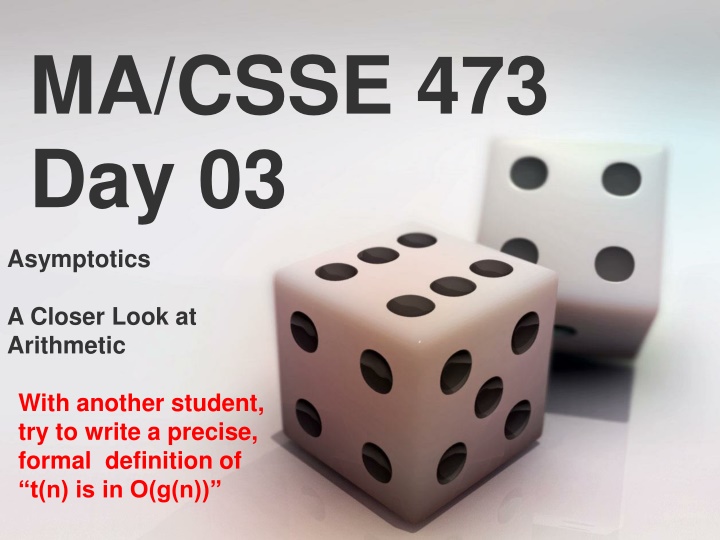
Formal Definition of Asymptotic Notation: t(n) ∈ O(g(n))
Delve into the precise, formal definition of t(n) being in O(g(n)), a fundamental concept in analyzing algorithmic efficiency and growth rates. Learn how to identify and compare functions in asymptotic notation.
Download Presentation

Please find below an Image/Link to download the presentation.
The content on the website is provided AS IS for your information and personal use only. It may not be sold, licensed, or shared on other websites without obtaining consent from the author. If you encounter any issues during the download, it is possible that the publisher has removed the file from their server.
You are allowed to download the files provided on this website for personal or commercial use, subject to the condition that they are used lawfully. All files are the property of their respective owners.
The content on the website is provided AS IS for your information and personal use only. It may not be sold, licensed, or shared on other websites without obtaining consent from the author.
E N D
Presentation Transcript
MA/CSSE 473 Day 03 Asymptotics A Closer Look at Arithmetic With another student, try to write a precise, formal definition of t(n) is in O(g(n))
Day 3 Student questions Course policies? HW assignments? Anything else? The two early course threads Review of asymptotic notation Addition and multiplication algorithms
Two threads in lectures Each day at the beginning of the course A little review (today it's a lot) Continue with discussion of efficiency of Fibonacci and arithmetic (if there is time). Review thread for today: Asymptotics (O, , ) Mostly a recap of 230 lecture on same topic. I
Rapid-fire Review: Definitions of O, , I will re-use some of my slides from CSSE 230 Some of the pictures are from the Weiss book. And some of Levitin's pictures A very similar presentation appears in Levitin, section 2.2 Since this is review, we will move much quicker than in 230
Asymptotic Analysis We only really care what happens when N (the size of a problem) gets large Is the function linear? quadratic? exponential? etc.
Asymptotic order of growth Informal definitions A way of comparing functions that ignores constant factors and small input sizes O(g(n)): class of functions t(n) that grow no faster than g(n) (g(n)): class of functions t(n) that grow at same rate as g(n) (g(n)): class of functions t(n) that grow at least as fast as g(n)
Formal Definition We will write a precise formal definition of "t(n) O(g(n))" This is one thing that students in this course should soon be able to do from memory and also understand it, of course!
Prove a Big O Property For any function g(n), O(g(n)) is a set of functions We say that t(n) O(g(n)) iff there exist two positive constants c and n0 such that for all n n0, t(n) c g(n) Rewrite using and notation If f(n) O(g(n)) and t(n) O(g(n)), then f(n)+t(n) O(g(n)) Let's prove it Q 2
Big O examples All that we must do to prove that t(n) is O(g(n)) is produce a pair of numbers c and n0 that work for that case. t(n) = n, g(n) = n2. t(n) = n, g(n) = 3n. t(n) = n + 12, g(n) = n. We can choose c =3 and n0 = 6, or c = 4 and n0 = 4. t(n) = n + sin(n) t(n) = n2 + sqrt(n) In CSSE 230, we do these in great detail in class. In 473, I say, "work on them if you need review/practice, " and give you a few possible answers on the next slide.
Answers to examples For this discussion, assume that all functions have non- negative values, and that we only care about n 0. For any function g(n), O(g(n)) is a set of functions We say that a function f(n) is (in) O(g(n)) if there exist two positive constants c and n0 such that for all n n0, f(n) c g(n). So all we must do to prove that f(n) is O(g(n)) is produce two such constants. f(n) = n + 12, g(n) = ???. g(n) = n. Then c =3 and n0 = 6, or c = 4 and n0 = 4, etc. f(n) = n + sin(n): g(n) = n, c = 2, n0 = 1 f(n) = n2 + sqrt(n): g(n) = n2, c=2, n0 = 1
Limits and asymptotics lim n ( ) t n Consider the limit ( ) g n What does it say about asymptotics if this limit is zero, nonzero, infinite? We could say that knowing the limit is a sufficient but not necessary condition for recognizing big-oh relationships. It will be sufficient for most examples in this course. Challenge: Use the formal definition of limit and the formal definition of big-oh to prove these properties. Q 3
Apply this limit property to the following pairs of functions 1. N and N2 2. N2 + 3N + 2 and N2 3. N + sin(N) and N 4. log N and N 5. N log N and N2 6. Na and Nn 7. aN and bN (a < b) 8. logaN and logbN (a < b) 9. N! and NN
Big-Oh Style Give tightest bound you can Saying that 3N+2 O(N3) is true, but not as useful as saying it s O(N) [What about (N3) ?] Simplify: You could say: 3n+2 is O(5n-3log(n) + 17) and it would be technically correct But 3n+2 O(n) is better But if I ask true or false: 3n+2 O(n3) , what s the answer? True!
BACK TO AND ARITHMETIC THREAD FROM LAST TIME:
The catch! Are addition and multiplication constant-time operations? We take a closer look at the "basic operations" Addition first: At most, how many digits in the sum of three decimal one-digit numbers? Is the same result true in binary and every other base? Add two k-bit positive integers (53+35): Carry: 1 1 0 1 0 1 (35) 1 0 0 0 1 1 (53) 1 0 1 1 0 0 0 (88) 1 1 1 1 So adding two k-bit integers is O( ).
Multiplication Example: multiply 13 by 11 1 1 0 1 x 1 0 1 1 1 1 0 1 (1101 times 1) 1 1 0 1 (1101 times 1, shifted once) 0 0 0 0 (1101 times 1, shifted twice) 1 1 0 1 1 0 0 0 1 1 1 1 (binary 143) There are k rows of 2k bits to add, so we do an O(k) operation k times, thus the whole multiplication is O( ) ? Can we do better? (1101 times 1, shifted thrice)
Multiplication by an Ancient Method This approach was known to Al Khwarizimi According to Dasgupta, et al, still used today in some European countries Repeat until 1st number is 1, keeping all results: Divide 1st number by 2 (rounding down) double 2nd number Example 11 13 5 26 2 52 1 104 143 Then strike out any rows whose first number is even, and add up the remaining numbers in the second column. Correct? Analysis
For reference: The Master Theorem The Master Theorem for Divide and Conquer recurrence relations: Consider the recurrence T(n) = aT(n/b) +f(n), T(1)=c, where f(n) = (nk) and k 0 , The solution is (nk) if a < bk (nk log n) if a = bk (nlogba) if a > bk For details, see Levitin pages 483-485 or Weiss section 7.5.3. Grimaldi's Theorem 10.1 is a special case of the Master Theorem. We will use this theorem often. You should review its proof soon (Weiss's proof is a bit easier than Levitin's).
New Multiplication Approach Divide and Conquer To multiply two k-bit integers x and y: Split each into its left and right halves so that x = 2k/2xL + xR, and y = 2k/2yL + yR The straightforward calculation of xy would be (2k/2xL + xR)(2k/2yL + yR) = 2kxLyL +2k/2(xLyR + xRyL) + xRyR Code on next slide We can do the four multiplications of k/2-bit integers using four recursive calls, and the rest of the work (a constant number of bit shifts and additions) in time O(k) Thus T(k) = . Solution?
Code for divide-and-conquer multiplication
Can we do better than O(k2)? Is there an algorithm for multiplying two k-bit numbers in time that is less than O(k2)? Basis: A discovery of Carl Gauss (1777-1855) Multiplying complex numbers: (a + bi)(c+di) = ac bd + (bc + ad)i Needs four real-number multiplications and three additions But bc + ad = (a+b)(c+d) ac bd And we have already computed ac and bd when we computed the real part of the product! Thus we can do the original product with 3 multiplications and 5 additions Additions are so much faster than multiplications that we can essentially ignore them. A little savings, but not a big deal until applied recursively!
Is this really a lot faster? Standard multiplication: (k2) Divide and conquer with Gauss trick: (k1.59) Write and solve the recurrence But there is a lot of additional overhead with Gauss, so standard multiplication is faster for small values of n. In reality we would not let the recursion go down to the single bit level, but only down to the number of bits that our machine can multiply in hardware without overflow.



